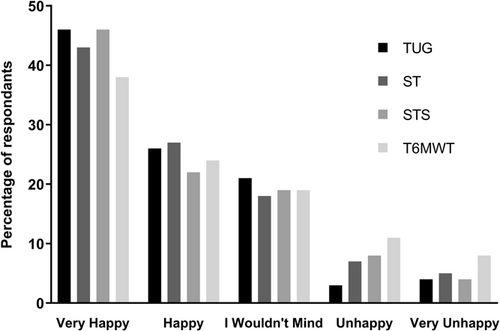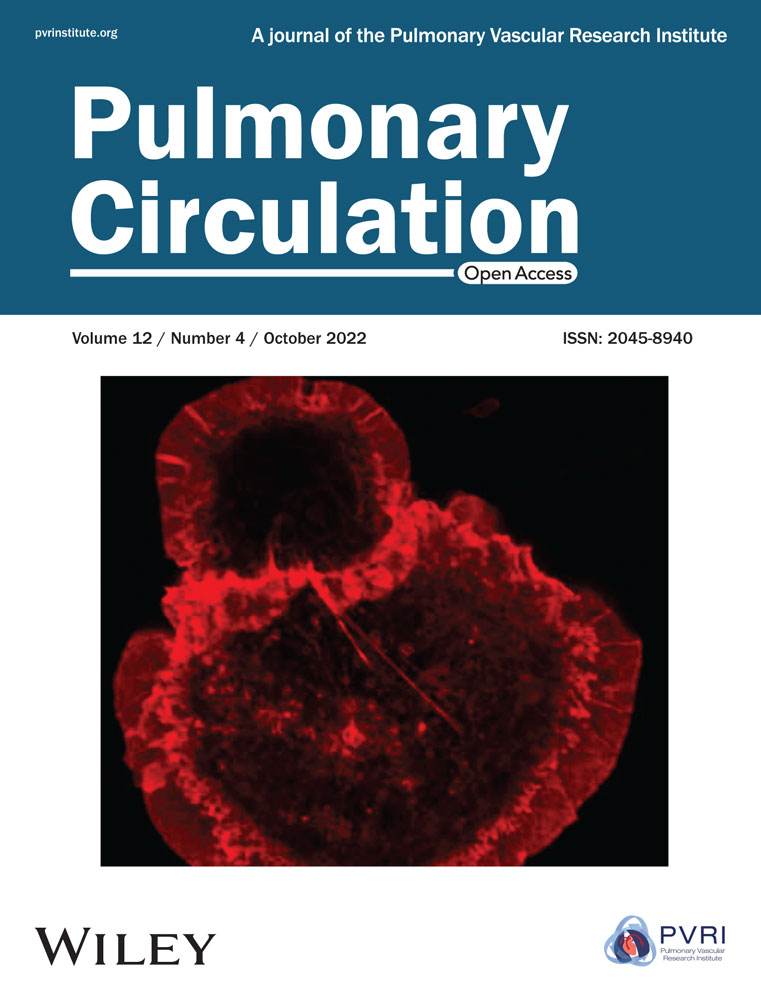Towards telemedicine in pulmonary hypertension: Assessing the feasibility of remote quality of life and exercise capacity assessment
Abstract
Patients with pulmonary hypertension (PH) are happy to perform simple exercise capacity tests at home and believe this is feasible. A proportion of patients are able to use an electronic form to complete quality of life questionnaires. These findings are being used to build a telemedicine strategy for PH patients.
The 2019 COVID-19 pandemic led to widespread disruption of outpatient services across United Kingdom as limitations were placed upon travel and face-to-face contact with patients was reduced.1, 2 The Scottish Pulmonary Vascular Unit (SPVU) is responsible for the care of patients with pulmonary hypertension (PH) in Scotland and during the first wave of the pandemic had to move rapidly to a telephone appointment model for outpatient appointments. The routine follow-up of patients at SPVU involves a reassessment of 6-min walk distance, N-terminal prohormone of BNP (NT-proBNP), World Health Organization functional class and quality of life (QOL), as assessed by the emPHasis-10 questionnaire.3 To strengthen the SPVU telemedicine strategy, several studies are in progresses to evaluate how each of these metrics could be performed by patients at home. This letter describes preliminary reports from two of these studies which assess patients' opinions of remote exercise testing and the feasibility of remote QOL assessment.
PATIENTS' OPINIONS OF REMOTE EXERCISE TESTING
The development of a set of valid exercise tests that could be performed outwith a hospital would enable a remote assessment of exercise capacity. A study is currently recruiting at SPVU evaluating four alternative exercise tests to the standard 6MWT namely a Timed Up and Go Test (TUG), a 2-min Step Test (ST), a 1-min Sit-to-Stand Test (STS) and a tele-6-min walk test (T6MWT). The latter was a test of how far a patient can walk in 6 min in an outdoors setting measured by a smartphone application which uses global positioning satellite (GPS) data and a timer.4 To establish how patients would perceive performing these tests unsupervised at home, a self-completed questionnaire was developed and sent to all patients with PH who were receiving treatment at the SPVU in November 2020. Patients were given information on the above tests and were asked how willing they would be to perform these at home and how feasible they believed this would be. Information was collected on patient's current technology use and mobility.
Questionnaires were sent to 460 patients and responses were received from 189 (response rate 41%). A total of 121 (68%) patients owned a smartphone of whom 69 used an Apple iPhone and 52 used an Android device. A total of 41 (23%) patients used a mobile phone that did not have internet access. A total of 7% of patients did not use any form of mobile phone. A total of 43% of patients currently owned a pulse oximeter. A total of 18% of patients left their home and garden less than once a week, 49% left more than once a week and 34% left every day. A total of 5% of patients were unable to walk any distance. A total of 42% of patients use oxygen indoors. A total of 17% of patients used a walking aid indoors, rising to 30% when outdoors.
The majority of patients felt it was feasible to perform all four tests at home, TUG (90%), ST (85%), and STS (86%), but this was significantly lower for the T6MWT (68% of patients, p < 0.05). 10% of patients felt unable to perform any of the four tests. Figure 1 shows how comfortable patients felt about completing the test at home.

The majority of patients did not have concerns about performing the four tests at home (86% TUG, 77% ST, 79% STS, 71% T6MWT). A total of 2%–4% of patients were worried the tests would make them feel unwell, 6%–10% were worried they would fall during the test and 3%–9% were worried they would be unable to complete the tests. Specific concerns regarding each test included 5% of patients feeling unable to walk onto a step for the ST and 6% of patients requiring to use their arms to sit up for a STS test. A total of 73 (39%) patients had concerns with the T6MWT. These included unsuitability of the area around their home (hilly or unsafe) and inclement weather, especially in winter.
REMOTE QOL ASSESSMENT
A pilot study was performed to assess whether the emPHasis-10 form could be completed electronically by patients at home. If feasible, this would reduce the administration and environmental costs of posting paper copies, would allow the form to be completed in private and for QOL to be assessed ad hoc. The primary aim of this would be to improve the response rate for return. In a routine mailshot to patients in March 2022 they were asked to complete an emPHasis-10 form. They were given the options of completing this using a web-based form or by phoning or emailing the result back to the unit. The web-based emPHasis-10 form was created using Google Forms (Google, Alphabet Incorporated, California, United States) which was identical to the paper emPHasis-10 and included the same questions and responses. A brief set of instructions, including a quick response code and URL to the Google Form, was sent in the mailshot. Patients were given an anonymised 3 digit identifier to supply when they completed the form.
A total of 420 patients were contacted and 141 responses received (response rate 33.5%). Of the 141, 111 (79%) were completed using the electronic form and 30 (21%) were completed by phone or email. Of the total population who received the mailshot, 26% were able to complete the web-based emPHasis-10 form.
DISCUSSION
The results from the questionnaire demonstrate that the majority of patients with PH are happy to perform home exercise tests and feel that these are feasible. However, we found variation between acceptance of the different tests, an observation supported by a recent review of remote exercise testing in chronic respiratory conditions.5 The remote version of the 6MWT (T6MWT) is likely to be highly beneficial as the standard 6MWT has been extensively validated in PH and T6MWT results could be easily interpreted.6 However, the proportion of patients who were overall happy to complete the T6MWT was the lowest of the four. Patient identifiable information was not collected to simplify the questionnaire and therefore improve the response rate. However, we presume barriers to such a test reflect the increased requirements of the test such as an internet-enabled smartphone, a strong GPS signal, good weather conditions and a suitable environment around patients' homes. Smartphone use in this cohort was 68%, compared to the United Kingdom 2019 national average of 88%.7 The TUG, STS, and ST are more straightforward tests and subsequently patients would be happier to perform these remotely. A combination of factors, including patient choice, the relative frailty of this population and the lack of universal smartphone use, means a range of remote exercise tests may be required to meet the needs of this patient group. Ensuring each patient is content and capable of performing home exercise tests will improve compliance and safety whilst unsupervised at home.
It is a requirement of the National United Kingdom PH Audit that QOL scores are recorded annually in 90% of patients and during the coronavirus pandemic (2020–2021) this target was not met, with an average of 76% completion across the UK centers.8 This pilot study demonstrated that remote reporting of QOL scores using an electronic form was performed by a quarter of patients with PH and therefore may enable centers to improve their performance in this metric. This method achieved a greater response rate than a traditional paper form with telephone or email reporting of the result which reflects its simplicity and ease of use. However, the number of responses overall remained low, likely to a combination of motivation and difficulty using electronic technology and/or lack of smartphone ownership.
These feasibility studies are part of a greater network of investigations at SPVU into remote monitoring in PH. Based on feedback from the questionnaire, a study was developed and is in progress evaluating the validity and feasibility of the four exercise tests as compared to the standard 6MWT when tested at patients' homes. A further study, in partnership with the Royal Brompton Hospital in London, is in progress to evaluate the validity of capillary testing of NT-proBNP to assess the utility of home testing.9 This letter describes reports from two studies looking at measures of exercise capacity and QOL. Together these studies aim to allow an evidence-based platform on which a build a robust telemedicine clinic for patients with PH.
AUTHOR CONTRIBUTIONS
Harrison Stubbs: data curation, methodology, formal analysis, writing – original draft; Melanie Brewis: writing – review & editing; Colin Church: writing – review & editing; Martin Johnson: conceptualization, supervision, writing – review & editing, project administration.
CONFLICTS OF INTEREST
The authors declare no conflicts of interest.
ETHICS STATEMENT
Not applicable.




